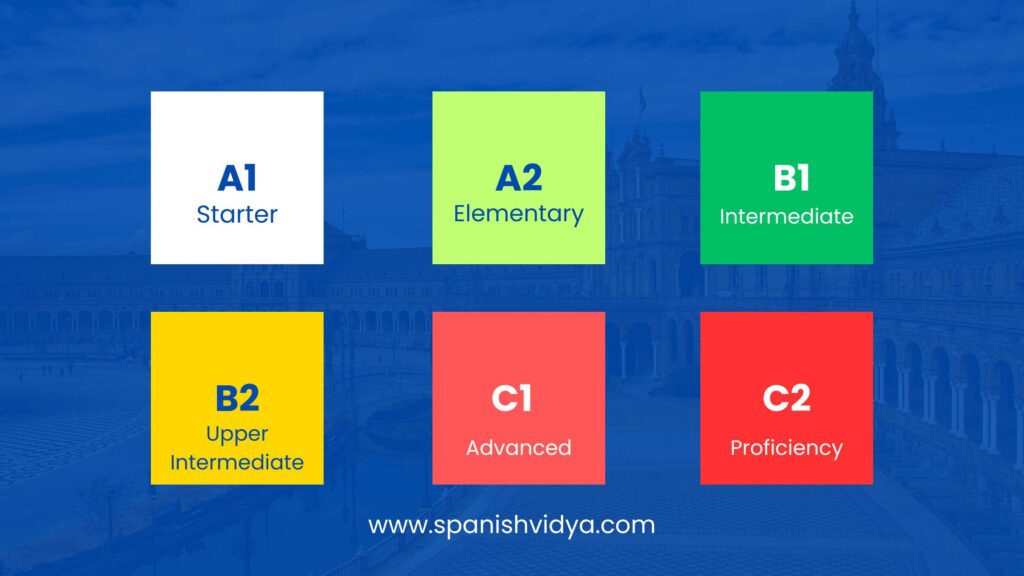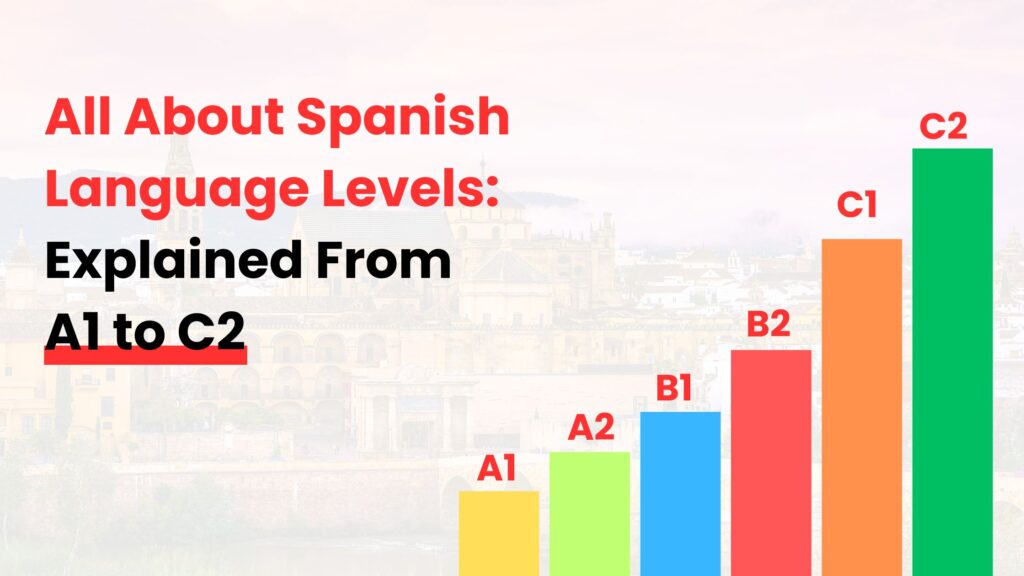Did you know that the romantic language of Spanish, also known as Castilian, originated on the Iberian Peninsula? Around 460 million people speak it in the entire world. Additionally, 21 nations, including Spain, Mexico, Colombia, and Argentina, have Spanish as their official language. Therefore, if you learn Spanish, you will be able to communicate with people everywhere! But for this you need to understand about different Spanish Language Levels.
When learning Spanish, it is critical to understand the various levels of proficiency. They assist you in setting objectives and monitoring your progress by outlining the various levels of language proficiency, from beginner (A) to expert (C2).
We will answer all of your inquiries about Spanish language levels using the CEFR system in this article. All languages have the same CEFR levels in terms of descriptions, but for the purposes of this article, we will focus on Spanish fluency levels.
All About the Spanish Language Levels:
The CEFR levels, which are denoted by the letters and numbers A1 to C2, are probably familiar to anyone learning a language in Europe (or another European language). Then again, what are these levels, and how does the global levelling system operate?
What Spanish levels are there according to CEFR?
The Common European Framework of Reference for Languages is known as CEFR. Spanish students and teachers can assess language proficiency and fluency using the six levels that make up the levels. The proficiency levels will essentially range from someone who is a beginner to someone who has advanced and close to native Spanish proficiency.

You would need to pass either the DELE or the SIELE test, which is a specialized exam that evaluates your skills, to receive an official CEFR Spanish language level.
The CEFR levels represent a global benchmark for a person’s language proficiency. Knowing one’s level of language proficiency in comparison to others as well as other languages one speaks can be helpful.
Four skill areas—listening, speaking, reading, and writing—have a comprehensive list of descriptions of ability in the CEFR levels. As a result, rather than just looking at someone’s reading or listening comprehension skills, their overall aptitude is evaluated.
As a starting point, the CEFR levels
Since CEFR is the most popular system for evaluating languages globally, it serves as a foundation for creating syllabuses for curricula all over the world. Many of the topics covered in global language curricula will be taken directly from CEFR-level descriptions.
What advantages do CEFR levels offer?
Numerous educational institutions and teachers around the world can immediately understand the Spanish language proficiency levels of their students when those levels are determined using CEFR standards.
Furthermore, you can say that you are equally proficient in both languages if your Spanish and Italian are both at the C1 level. In the field of employment, CEFR levels have another advantage. Knowing your CEFR level can be very helpful if you are applying for a job abroad or one that involves a lot of international travel and communication. You can actually describe your education and proficiency in terms that people in other countries will understand rather than simply stating that you have a GCSE or A Level in Spanish from the UK.
What is the breakdown of the CEFR levels?
It is important to keep in mind that the CEFR levels for Spanish are the same as for other languages. As a result, some languages require more effort to learn in order to reach C2 proficiency. For instance, a native English speaker would find it simpler to reach the C2 level in Spanish than in German because Spanish is easier for English speakers to learn.
Six stages were created when the Council of Europe created the CEFR levels: A1, A2, B1, B2, C1, and C2. Let us examine what each level of Spanish proficiency entails.
Beginner Spanish Level A1
This is the place to begin! The foundational level, A1, is where you start to build your vocabulary and communication abilities in the language. It is unlikely that, after completing the Spanish A1 level syllabus and reaching this level, you will be able to converse fluently with a native speaker, but you will be able to:
- Give a brief introduction to and description of yourself.
- cite a few basic Spanish phrases
- Ask for directions and adhere to them
- Spot the differences between words and phrases when speaking Spanish.
- Read books for kids.
This level becomes the starting point for reaching the rest of the language levels.

Also Check – Important A1 Level Vocabulary
Beginner Spanish Level A2
Following the Spanish A1 level, you will advance to this level, where you will develop your vocabulary to carry on a conversation. You can visit a country like Mexico that speaks Spanish if you reach this level. You can carry out the following tasks after your A2 level Spanish course:
- Listen to Spanish podcasts about shopping, visiting hospitals, traveling, and corresponding with friends.
- While speaking with the interlocutor and when composing letters, use various tenses.
- Navigate timetables at public transportation stops, read a straightforward newspaper advertisement, and comprehend the information on a restaurant menu.
Intermediate B1 Spanish level
The initial Spanish levels that provided you with a foundational understanding of the language are just the start. By learning the language and using it in actual conversations while attending the B1 Spanish course, you will be able to:
- Converse with native Spanish speakers and be more at ease.
- Read easy Spanish-language books
- Express your viewpoint and back it up with some facts.
- Observe and comprehend complete sentences
Intermediate B2 level of Spanish
Many individuals who have mastered B2 can easily work as a manager, sales consultant, courier, or cab driver abroad. Additionally, because it is a popular tourist destination, taking classes will help you land a job that requires proficiency in both English and Spanish.
The following activities will be possible for students who have successfully completed intermediate Spanish level B2.
- Without a dictionary, you can easily communicate with Spanish speakers.
- In a debate or conversation, defend your point of view.
- Prepare concise monologues where you defend your own position.
- Discuss your thoughts and values.
- Watch movies in their original language, and it is simple to read books.
Advanced Spanish Level C1 and C2
These levels correspond to professional Spanish, so after taking Spanish classes, you will need to pass an exam to receive a certification. At these levels of Spanish, you will be able to: Participate in conferences and speeches if you have advanced Spanish (C1 or C2), which some universities in Mexico require of foreign students seeking master’s or doctoral degrees.
- Possess a vocabulary that is very specialized
- You can interact with others in a professional setting with some ease.

When are Spanish CEFR levels significant?
Only those looking to gauge a person’s level of Spanish fluency should be concerned with these levels. What level of Spanish am I at is also helpful for people who urgently require it.
People also find these levels helpful for employment purposes. It is beneficial to have the option of adding Spanish proficiency levels for resumes or applications to universities.
Last thoughts
Now that you know what the different Spanish language levels mean, hopefully, you will be able to use them effectively. Maybe you have also been able to determine roughly where your Spanish proficiency stands.
Remember that you do not need to worry too much about your Spanish proficiency unless you absolutely must know it or you use it as motivation. After all, learning a language should be enjoyable!
Learning Spanish With Spanish Vidya
Our proficiency levels in Spanish Vidya are in line with the Common European Framework of Reference for Languages (CEFR), a standard used to describe the accomplishments of language learners all over the world.
The CEFR categorizes learners into three broad groups (A, B, and C), each of which can be further divided into six levels (A1, A2, B1, B2, C1, and C2); for each level, it specifies the skills that a learner should be able to perform in reading, listening, speaking, and writing. In addition, we adhere to the Instituto Cervantes’ rules. The institution is the biggest organization in the world in charge of encouraging the study and teaching of Spanish language and culture, organizing the DELE exams for Spanish as a Foreign Language, and creating the CEFR specifically for the Spanish language.
FAQs
- What are the levels of Spanish A1 to C2?
There are six levels in the Spanish language: A1, A2, B1, B2, C1, and C2. The levels are as follows:
A1 – Beginner
A2 – Elementary
B1 – Intermediate
B2 – Upper-Intermediate
C1 – Advanced
C2 – Proficient
- How long does it take to reach C2 Spanish?
Spanish proficiency at the C2 level can take a variety of times, but it typically requires several years of consistent, immersive study and practice. Depending on individual commitment, level of immersion, and language learning techniques, it could take anywhere from 5 to 10 years on average.
- How fast can you realistically learn Spanish fluently?
Realistically, learning to speak Spanish fluently requires at least 600-750 hours of focused study and practice. However, this number can vary depending on a person’s background, exposure to other languages, language similarity, and degree of immersion. With consistent effort, it can frequently be reached within six months to two years.
- How many words do you need to know to be fluent in Spanish?
Usually, you need to know between 2,000 and 5,000 words in Spanish to be fluent. Fluency, however, involves more than just vocabulary; it also entails comprehending and effectively utilizing context and grammar.
- What is considered fluent in Spanish?
Being able to speak, listen, read, and write in Spanish with ease is referred to as fluency. It involves being able to comprehend and communicate ideas in various contexts without much difficulty, even if you might not know every word.
- What level is considered bilingual?
Being bilingual is frequently defined as having fluency in two languages, typically at the B2 or C1 levels of the CEFR (Common European Framework of Reference for Languages) scale.

